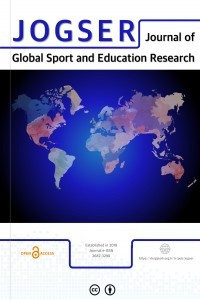Şampiyon Erkek Tenisçilerin Maç Analizleri
Amaç: 2011 Grand Slam tenis turnuvalarında (Avustralya açık, Fransa açık, Wimbledon, Amerika açık) tekler kategorisinde şampiyon olan erkek tenisçilerin maç istatistiklerinin analizini yapmaktır.Yöntem: Araştırmada veri toplama aracı olarak 2011 Grand Slam tenis turnuvalarının resmiinternet sayfaları kullanılmıştır. Bu sayfalardaki müsabakalar süresince yayınlanan tekler kategorisi şampiyon erkek tenisçilerin toplam 25 maç sonucu değerlendirilmeye alınmıştır. Çalışmada turnuvaların maç değişkenleri incelenmiştir. Elde edilen verilerin tanımlayıcı istatistik analizleri (aritmetik ortalama, standart sapma, frekans dağılımı) ve turnuvalar arası karşılaştırmada tek yönlü varyans analizi (ANOVA), Tukey post-Hoc testi yapılmış, çalışmanın istatistiksel analizinde SPSS 16,0 paket programı kullanılıp anlamlılık düzeyi p<0,05 olarak belirlenmiştir. Bulgular: Bu araştırma sonucunda; şampiyon erkek tenisçilerin değerlendirilen maç istatistiklerinde; 1. Servis yüzdesi, aces, ortalama 1. servis hızı ve ortalama 2. Servis hızında turnuvalar arası anlamlı farklar çıkarken (p<0.05), diğer verilerde anlamlı bir fark tespit edilmemiştir. Sonuç: Genelde hızlı kortlarda (Wimbledon) servis değerleri yüksek çıkarken, yavaş (Fransa açık) kortlarda düşen servis hızları ile birlikte servis yüzdelerinin arttığı tespit edilmiştir. Diğer değişkenlerde genelde yakın değerler tespit edilmiştir.
Anahtar Kelimeler:
Tenis, Grand Slam, maç analizi
___
- Barnett, T., and Clarke, S.R. (2005). Combining player statistics to predict outcomes of tennis matches. IMA Journal of Management Mathematics,16(2), 113-120.
- Cui, Y., Gómez, M.Á., Gonçalves, B. and Sampaio, J. (2018). Performance profiles of professional female tennis players in grand slams. PloS one, 13(7), e0200591.
- Del Corral, J., and Prieto-Rodriguez, J. (2010). Are differences in ranks good predictors for Grand Slam tennis matches?. International Journal of Forecasting, 26(3), 551-563.
- Fernandez-Fernandez, J., Mendez-Villanueva, A., and Pluim, BM. (2006). Intensity of tennis match play, Br J Sports Med, 40:387–391.
- Filipcic, A., Caks, K.K., and Filipcic, T. (2011). A Comparıson Of Selected Match Characterıstıcs Of Female Tennıs Players/Prımerjava Izbranıh Igralnıh Znacılnostı Prı Tenıskıh Igralkah. Kinesiologia Slovenica, 17(2), 14.
- Filipcic, A., and Filipcic, T. (2002). Analysis of time and game characteristics in top profile tennis. Extraído el, 25.
- Filipcic, A., Zecic, M., Reid, M., Crespo, M., Panjan, A., and Nejc, S. (2015). Differences in performance indicators of elite tennis players in the period 1991-2010. Journal of Physical Education and Sport, 15(4), 671.
- Filipcic, T., Filipcic, A., and Berendijas, T. (2008) Comparison of game characteristics of male and female tennis players at Roland Garros, Acta Univ Palacki Olomuc. Gymnica, 38(3), 21-28.
- Hizan, H., Whipp, P. R., and Reid, M. (2010). Validation of match notation (a coding system) in tennis. Journal of Quantitative Analysis in Sports, 6(3).
- http://www.usopen.org/en_US/scores/draws/index.html?promo=topnav (Erişim tarihi: Kasım, 2011)
- http://www.wimbledon.com/en_GB/scores/draws/ms/index.html (Erişim tarihi: Ağustos, 2011)
- http://en.wikipedia.org/wiki/Grand_Slam_(tennis) (Erişim tarihi: 2014)
- http://www.ausopen.com/en_AU/scores/draws/index.html (Erişim tarihi: mart, 2011)
- http://www.itftennis.com, ITF Guide to Test Methods for Tennis Court Surfaces, (Erişim tarihi: 19 Haziran 2016)
- http://www.rolandgarros.com/en_FR/scores/draws/ms/index.html (Erişim tarihi: Ağustos, 2011)
- Kondric, M., Sekulic, D., Uljevic, O., Gabrilo, G., Zvan, M. (2013): Sport nutrition and doping in tennis: An analysis of athletes’ attitudes and knowledge. Journal of Sports Science and Medicine, 12(2): 290–297.
- Kovalchik, S.A., and Ingram, M. (2018). Estimating the duration of professional tennis matches for varying formats. Journal of Quantitative Analysis in Sports, 14(1), 13-23.
- Maquirriain, J., Baglione, R., and Cardey, M. (2016). Male professional tennis players maintain constant serve speed and accuracy over long matches on grass courts. European journal of sport science, 1-5.
- Norton, P., and Clarke, S.R. (2002). Serving up some grand slam tennis statistics. In Proceedings of the 6M&CS, G. Cohen and T. Langtry eds (pp. 202-209).
- O’Donoghue, P. (2001b). The most important points in grand slam singles tenis, Res Q Exerc Sport.72 (2), 125-31.
- O’Donoghue, P. G., and Ballantyne, A. (2004). The impact of speed of service in Grand Slam singles tennis. In A. Lees, J. F. Kahn, & I. Maynard (eds), Science and Racket Sports III (pp. 179–184). London and New York: Routledge.
- O’Donoghue, P., and Ingram, B. (2001a). A notational analysis of elite tennis strategy. J Sport Sci, 19:107–15.
- Over, S., and O’Donoghue, P. (2008). What’s the point–Tennis analysis and why. ITF Coaching and Sport Science Review, 15(45), 19–21.
- Reid, M., Morgan, S., and Whiteside, D. (2016). Matchplay characteristics of Grand Slam tennis: implications for training and conditioning. Journal of sports sciences, 1-8.
- Smekal, G., Von Duvillard, S.P., Rihacek, C., Pokan, P., Hofmann, R., Baron, H., Tschan, N., and Bachl, A. (2001). A physiological profile of tennis match play. Med Sci Sports Exerc, 33:999–1005.
- Yayın Aralığı: Yılda 2 Sayı
- Başlangıç: 2018
- Yayıncı: Cenk TEMEL
Sayıdaki Diğer Makaleler
Nimet HAŞIL KORKMAZ, Çiğdem GÖKDUMAN, Meral TANER DERMAN
Şampiyon Erkek Tenisçilerin Maç Analizleri
Türkiye’de Spor Yönetimi Alanında Yapılan Akademik Çalışmaların Analizi
Yüsra YAVUZ, Nevzat MİRZEOĞLU, Yakup KAYMAKÇI
Beden Eğitimi ve Spor Eğitimi Alan Öğrencilerin Yaşam Boyu Öğrenme Eğilimlerinin İncelenmesi
